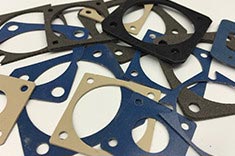EMI Shielding Products
- Custom Gasket Fabrication
- Connector Gaskets
- Bonded O Ring
- Custom Gaskets
- Conduct-O-Knit Knitted Wire Mesh
- Conduct-O-Seal Combo Gasket
- Conduct-O-Elastomer
- Conduct-O-Seal Oriented Wire in Silicone Gasket Material
- Conduct-O-Mesh Tape
- Conduct-O-Foam
- Conduct-O-Bond
- Optical Filters For Electronic Displays
- Shielded Vent Panels
- ESC Board Level Shielding
- 300 Series
Understanding Filler Materials for Effective EMI Shielding Solutions

Electromagnetic interference (EMI) can significantly degrade the performance of electronic devices, causing malfunctions and even complete failure. As electronic devices continue to proliferate, it becomes increasingly important to incorporate EMI shielding components. This article will focus on the various filler materials used for shielding EMI and the factors to consider when selecting the right filler material.
Filler Materials for EMI Shielding
Filler materials are essential in EMI shielding solutions, providing the conductive properties necessary to block electromagnetic radiation. These materials can be integrated into coatings, gaskets, and other shielding components.
- Metal Fillers
- Silver
- Highly conductive and effective for shielding EMI
- Expensive due to the material's cost
- Copper
- Good electrical conductivity and relatively cost-effective
- Susceptible to corrosion
- Nickel
- Offers excellent EMI shielding performance
- More affordable than silver but less conductive
- Conductive Polymers
- Inherently Conductive Polymers (ICPs)
- Offer good EMI shielding and electrical conductivity
- Lightweight and flexible so they work for various applications
- Electrically Conductive Composites (ECCs)
- Created by combining conductive fillers with a polymer matrix
- Provide good shielding performance while maintaining the base polymer's mechanical properties
- Carbon-based Materials
- Graphene
- Exceptional electrical conductivity and EMI shielding capabilities
- High cost and complex manufacturing processes limit widespread adoption
- Carbon Nanotubes (CNTs)
- Excellent EMI shielding properties and electrical conductivity
- Relatively high cost compared to other materials
Selecting the Right Filler Material
Choosing the most appropriate filler material for your EMI shielding application requires careful consideration of several factors:
- Shielding Effectiveness: The primary goal of EMI shielding is to protect against electromagnetic interference. Assess the shielding effectiveness of the filler material to ensure it meets your application's requirements for shielding EMI.
- Cost: Budget constraints may influence the choice of filler material. Silver, for example, offers excellent shielding properties but is more expensive than other options like copper and nickel.
- Corrosion Resistance: Some filler materials, like copper, are prone to corrosion. Consider the operating environment of your electronic device and choose a filler material with suitable corrosion resistance properties.
- Weight and Flexibility: The weight and flexibility of the filler material can impact the overall design and performance of your EMI shielding solution. Lightweight and flexible materials like conductive polymers may be more suitable for specific applications.
- Compatibility: Ensure that the filler material is compatible with the surrounding materials and components, preventing potential degradation or adverse effects on performance.
Related Reading
- What is the Best Way to Protect Against Electromagnetic Interference?
EMI Shielding is an ideal way to contain interference because it can reflect electromagnetic waves. The shielding material absorbs the waves that are not reflected.
- How to Test the Effectiveness of RF Shields
- What is the Basic Function of EMI Gaskets?



